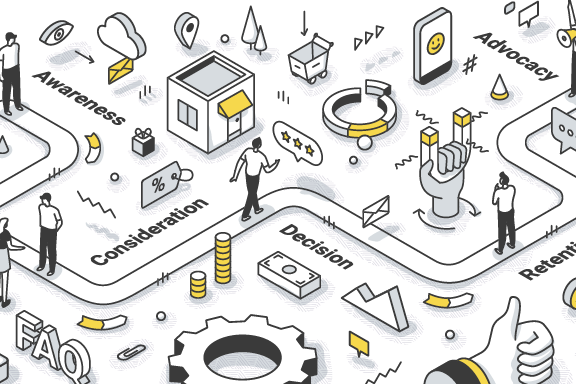We recently hosted our quarterly Association Analytics Network meeting on October 3, 2017 at the American Society of Association Executives (ASAE) where we discussed how to best serve your association customers. We also shared new ideas and best practices in the area of customer journey analytics.
Joining us for lunch, networking, and thought-provoking discussions were some of our clients and invited guests. Here’s a high-level summary of topics we covered during this enjoyable afternoon meeting.
The Customer Journey
A customer journey is a set of interactions a customer has with a brand. It begins when they become aware of your service. Touchpoints are all of the ways the customer interacts with your brand via different channels. They are specific interactions from a customer-centric view and can be numerous depending upon the channel. For example, online advertising, social media, direct emails, press releases, and event evaluations are all examples of touchpoints. However, a holistic view of the journey needs to be considered. Focusing on only a few touchpoints decreases the importance of others.
Brand experiences happen over time. Therefore, it’s important to carefully manage each point of interaction, as the customer journey crosses multiple channels and business functions. Understanding your customer’s journey begins with customer journey analytics.
Data Augmentation
Understanding your customers allows you to serve them better. Data augmentation adds information from both internal and external sources, improving your base data. Knowing how to use the data you collect is important. How to augment your data is a process in itself.
First identify gaps in your current data—such as demographic and psychographic information. Then identify where to obtain missing and supplemental data. Sources can include internal surveys and free data like a recent census information found at Census.gov. Additionally, you can purchase data from sources such as Acxiom, Merkle, Thomon Reuters Eikon, and FICO. This type of data is often useful for marketing purposes. Lastly, defining how the data will be used ensures it is collected properly and is usable.
Data Priorities
During this year’s ASAE Annual Meeting in Toronto, we conducted a live poll of our audience during our session about Business Analytics Projects and Initiatives and what we discovered was surprising. Although these findings are from polling the attendees of one session—based on over a decade of experience we find these statistics to be representative of what we find at most associations.
Here are the 6 surprise findings that can help your association become data guided.
- Data isn’t easily available in one centralized location.
- Business staff doesn’t have the tools to easily access data.
- We don’t use visualization tools to understand our data.
- We don’t use data to effectively segment and target marketing.
- Data is recognized as an asset and analytics is seen as critical to success.
- Data analytics has the support of the CEO and board.
Data Governance
Having a sustainable data governance program will position your association for success.
In simplified terms, you want to:
- Know the data
- Protect the data
- Maximize the data value
Data Governance is essentially people, policy, procedures, and a plan of action. To implement, you will need to form a team, define the process, identify priorities, create a policy, and then develop a plan. Data must be recognized as an enterprise asset used to achieve strategic and operational goals.
When getting started with data governance for associations it’s essential to maintain and leverage one of your association’s most valuable assets – your data. Your customers and your association will be served well with the initiation and execution of a data governance program.
If you’d like to learn more about creating amazing association customers and receive an invite to our next quarterly Association Analytics Network meeting—sign-up for our monthly email newsletter.



